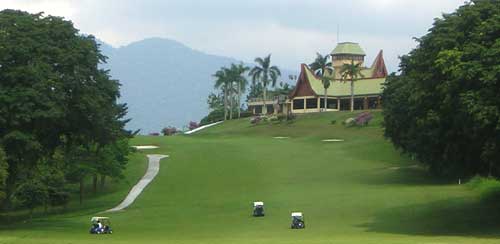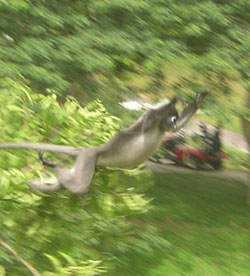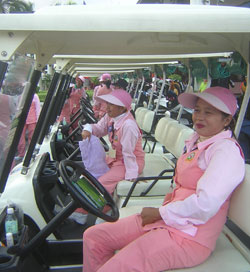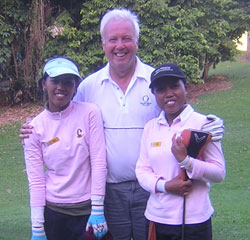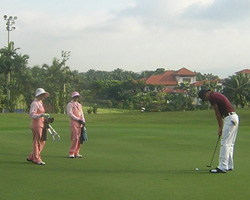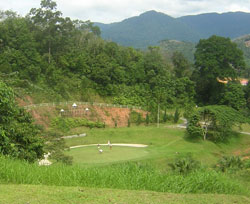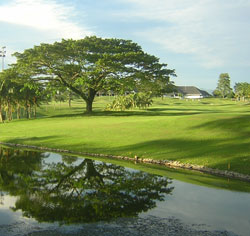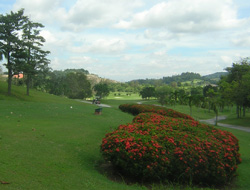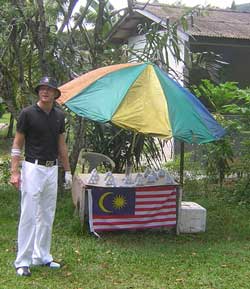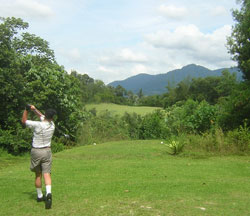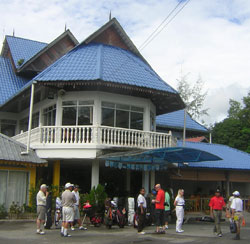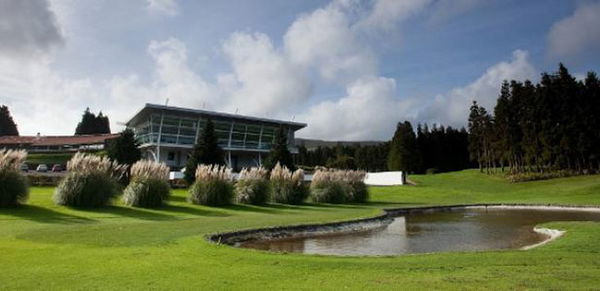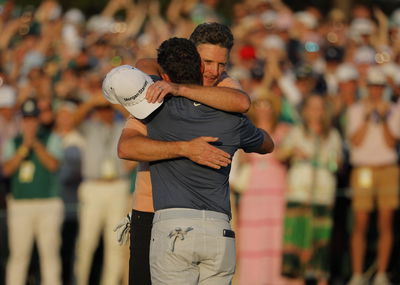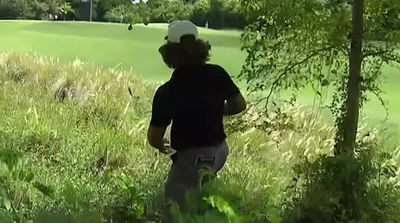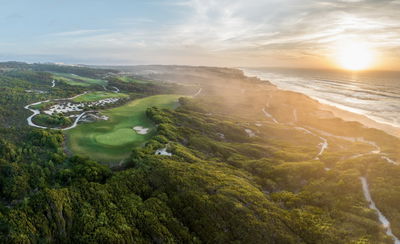Golf in Malaysia
'It's no coincidence that the recently crowned King is a keen golfer and solidly behind promoting golf in his country'

Teeing it up in Malaysia, it's easy to get distracted, especially if, like me, you're born with the radar hearing and peripheral vision of a Colin Montgomerie. At Seremban International Golf Club about 30 miles east of the capital Kuala Lumpur, a haunting afternoon call to prayer for the local Islamic community broke through the hot and steamy atmosphere from a nearby mosque as we prepared to hit our shots from the elevated first tee. | |
The following day long-tailed Macaque monkeys screamed and crashed through the jungle that immediately flanked the claustrophobic And then there were the caddies... Diminutive and demure young girls, in their identical costumes and caps of pink, scarlet or powder blue (depending on the course they represented) riding pillion on a small platform bolted to the back of each golf buggy. Valuable assistants or eye candy for the tourists? You decide. Each time I stopped our compulsory buggy they would immediately be at my shoulder with a couple of club options or searching through the undergrowth for a wayward drive. | |
At the green they'd dash ahead and mark and clean my ball, then replace it when it was my turn to putt, tending the flagstick as required. I hadn't the heart to tell them that after 35 years of replacing my own ball, crouching down and checking the line, it was something I preferred to do myself as part of my pre-shot routine. Instead I nodded gently, smiled courteously and let them get on with the job for which they had been carefully trained and for which I'd already paid 32 Ringgits (Malaysian currency equivalent to about £4.50) in advance. I'd have happily paid quadruple that amount if only they'd been able to read the putts as well as they prepared them for me to hit! | |
But sadly their contract of employment fell short of giving an accurate picture of how the ball would roll and curve on greens that were slick and unpredictable in behaviour due to the unusual phenomenon of 'grain' - the variable way in which the grass grows in this tropical climate. But despite the wailing of the Imam collecting his flock, the clatter of the monkeys and the buzzing around of the caddies, nothing distracts a golfer more than a fellow golfer - especially from another culture. And as part of media integration on this trip to familiarise ourselves with the golf experience in multi-cultural Malaysia, we were occasionally invited to share our fourball with golfers, not only from another continent but, it seemed, from another planet, whose understanding of the Rules bears little resemblance to those of us in the West. | |
Their interpretation of out of bounds - and with much of the jungle flanking most of the courses we played there was a lot of it - was to drop a ball without penalty at the point of entry. Their understanding of stableford was to keep playing until you holed out and if you took more than double bogey to record it as a two over par score. Furthermore, if your handicap decreed that you happen to receive one or more shots on that hole, all well and good - put yourself down for a point or two! As for tapping down spike marks on the line of a putt, chatting on your backswing and playing out of turn - all appeared common practice among the golfing press corps of Taiwan, Hong Kong, Korea, Thailand and Indonesia. At the risk of seeming xenophobic, I should absolve the Brits, Continental Europeans, Aussies, Canadian and most of the American contingent from this veiled criticism. They were charming and terrific company who were also eager to help Malaysian Tourism spread the word about its high quality golf facilities in 2007 - the 50th anniversary of the country's independence. It's perhaps no coincidence that the recently crowned King of Malaysia - one of its 14 regions nominates the nation's Head of State every five years - is also a keen golfer. | |
Tuanku Mizan Zainal Abidin is a 45-year-old 14-handicapper and solidly behind golf development for tourists in Malaysia where green fees are moderately priced and great value, ranging from as little as 30-40 Malaysian Ringgits (£4-£6) for nine holes to 280 RM (£40) at The Mines Resort, where Tiger Woods and Mark O'Meara claimed the World Cup for the US in 1999. Sadly as it's a six hour motorway drive from Kuyala Lumpur, we didn't get to visit the east coast beach resort at However, our party of golfers of mixed race and mixed ability but sharing a passion for the game, had ample opportunity to discover why Malaysia is anxious to step up its promotion of its 120 courses not only on the mainland peninsular but on its island of Penang and in the states of Sarawak and Sabah, which border the north coast of Borneo. My visit was concentrated around Kuala Lumpur and Negeri Sembilan which was also hosting the 2007 World Amateur International Team Championship at Seremban International and Staffield golf clubs. | |
Seremban International is a course of two distinctive nines. The front with its short but lush 'cow grass' flanking neatly trimmed fairways, tends to snake up an down predictably between mature trees. The back nine is more interesting and home to among the oldest golf holes in Malaysia. It cuts through palms, pines and dense vegetation with changes in elevation and finishes with a par-5 that sweeps uphill to a clubhouse that stands like a palace on the hill. Staffield has a more Floridian feel to it, located 40 minutes south of Kuala Lumpur and designed in 1994 by Ross Watson and Australian pro Graham Marsh with three distinct loops of nine holes with a single storey clubhouse perched majestically above it. Seven Lakes and 82 bunkers, many of them stretching the length of a hole form the major visible hazards but the real foe is the fluffy-textured Bermuda - which swallows a ball then spits it out in an explosion of grass with the consistency of wire wool - so difficult to control and with little or no spin. As for the Tifdwarf greens they reach speeds of 10 or 11 feet and are tough to hold with your approach. | |
On the way there we also called in at Nilai Springs Golf and Country Club with its huge, colonial-style clubhouse and scarlet-tiled roof overlooking its 27 holes, named in three tantalising loops - Island, Pine and Mango. Here, we were told, you can have all the benefits of golf, swimming, badminton, squash and fine dining for just £3,000 for life membership for you and your family! It even has its own 14-lane ten pin bowling alley. In comparison, Royal Sri Menanti Golf Club in the hills above Kuala Lumpur is a more natural course, hacked out of the jungle, seemingly by hand, with fairways that look no bigger than a ribbon of green when glimpsed from tees cut deep into the forest. From most you need a strong nerve and confidence in your driver or, like one of my colleagues you soon lose many balls in the undergrowth and you're negotiating for a small bag of six almost new ones with one of the locals who's found them, for the equivalent of £1.50. In the UK we'd call them lake balls - here they're Jungle balls! | |
With monkeys chattering from unseen vantage-points and local music drifting through the tree tops, this is one of the most tranquil but unforgiving places in the world to play golf. Final stop on my tour was at the palatial We'd have loved to have sampled golf under artificial lights but sadly another tropical thunderstorm cut short our round as warning sirens sent our buggies racing for cover with caddies hanging on like motorcycle sidecar passengers cornering at Brands Hatch. | |
However, at least I got first hand knowledge of greens where reading the grain plays a vital part in putting. As we approached the putting surfaces dark areas appear like patches of damp. The trick, we were told, is to read a little more borrow into them than the lighter areas which are faster and down grain. Many of us were caught out by short putts suddenly turning away from the hole as the ball was gripped into the grain. With golf being a demonstrative sport where hand movement and gesticulation is common among frustrated players, visitors to Malaysia will have to be wary of their actions so as not to cause offence. For example, whereas the right hand should always be used when eating or when receiving objects, to use the right forefinger to point at places or people is considered offensive. If a Malaysian caddie needs to show you where your ball might be lost, don't be surprised to see her direct you with her right thumb with four fingers folded under. | |
Sadly I rarely got the thumbs up signal from my playing partners during my all too brief visit, courtesy of the Malaysian Tourist Board. Apart from occasional flashes of inspiration, the quality of my golf failed to live up to its surroundings While the food (a spicy mixture of Indian and Chinese) and the heat (around 21-28 degrees) was very much to my liking, I found the 80-90 per-cent humidity toward the end of a round, not only debilitating and draining but as distracting as the wildlife and its golf's colourful little helpers . But it's a small price to pay for the chance to sample so many different cultures in a country where golf is proving a great attraction to overseas visitors. Acknowledgements Golfmagic.com wishes to thank Guoman, Port Dickson and One World in Kuala Lumpur. |
